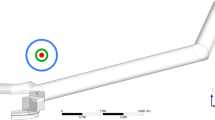Abstract
Heat flow in the flame zone of a direct-fired rotary kiln has been modeled mathematically. The flame has been assumed to be cylindrical in shape, backmixed radially, and moving axially in plug flow. The length of the flame and the rate of entrainment of secondary air have been characterized by empirical equations reported in the literature. It has been shown that the axial component of radiation can be reasonably neglected since it is relatively small compared to the radial component. The resulting one-dimensional model is capable of predicting the axial temperature profiles of the flame and wall and the axial profiles of heat flux to the solids bed and refractory wall. The model has been employed to study the influence on heat flow to the bed of the following variables: fuel type (fuel oil, natural gas, producer gas), firing rate, temperature of secondary air, pct primary air, and oxygen enrichment. Of the three fuels, combustion of fuel oil gives the longest flame and the greatest heat input to the solids in the flame zone. Raising the secondary-air temperature increases the flame length significantly but has a small effect on the maximum flame temperature and heat flux to the solids. Increasing percent primary air decreases the flame length and increases the peak values of flame temperature and solids heat flux but reduces the quantity of heat received by the solids in the flame zone. Oxygen enrichment results in a shorter flame, higher maximum flame temperature, and increase in the heat transferred to the solids in the flame zone.
Similar content being viewed by others
References
J.P. Gorog, J.K. Brimacombe, and T. N. Adams:Metall. Trans. B, 1981, vol. 12B, pp. 55–70.
J. P. Gorog, T. N. Adams, and J. K. Brimacombe:Metall. Trans. B, 1982, vol. 13B, pp. 153–63.
W. Trinks and M. H. Mawhinney:Industrial Furnaces, John Wiley and Sons, New York, NY, 1961, vols. I and II.
R.T. Read, ed.:North American Combustion Handbook, North American Mfg. Co., Cleveland, OH, 1978.
M. W. Thring:The Science of Flames and Furnaces, Chapman and Hall, London, 1962.
T. M. Beér and M. A. Chigier:Combustion Aerodynamics, Applied Science Publishers, London, 1972.
F. C. Lockwood, J. H. Whitelaw, and A. D. Gosman: “The Prediction of the Performance of Combustion Chambers and Furnaces”, Short course at Pennsylvania State University, April 1978.
N. H. Afgan and J. M. Beér:Heat Transfer in Flames, Scripta Book Co., Washington, DC, 1979.
W. Ruhland:J. Inst. of Fuel, 1973, vol. 40, pp. 69–75.
K. W. Pearce:J. Inst. of Fuel, 1973, vol. 46, pp. 363–71.
F.D. Moles, D. Watson, and P. B. Lain:J. Inst. of Fuel, 1973, vol. 46, pp. 353–62.
B.G. Jenkins and F.D. Moles:Trans. Inst. Chem. Eng., 1981, vol. 59, pp. 17–25.
H. Hottel and A. Sarofim:Radiative Transfer, McGraw-Hill, New York, NY, 1967.
R. W. Young and M. Cross:Iron and Steel Making, 1976, vol. 3, pp. 129–37.
J. P. Gorog: Ph.D. Thesis, Department of Metallurgical Engineering, University of British Columbia, Vancouver, B.C., 1982.
F. P. Ricou and D.B. Spaulding:J. Fluid Mech., 1961, vol. 11, pp. 21–32.
T. N. Adams: private communication, Weyerhaeuser Co., Tacoma, WA, 1982.
R. Graf and R. Payne: International Flame Research Foundation, 1981, Doc. No. F32/a/42.
A. P. Watkinson and J. K. Brimacombe:Can. J. Chem. Eng., in press.
Author information
Authors and Affiliations
Additional information
Formerly Graduate Student, University of British Columbia
Rights and permissions
About this article
Cite this article
Gorog, J.P., Adams, T.N. & Brimacombe, J.K. Heat transfer from flames in a rotary kiln. Metall Trans B 14, 411–424 (1983). https://doi.org/10.1007/BF02654360
Received:
Issue Date:
DOI: https://doi.org/10.1007/BF02654360




